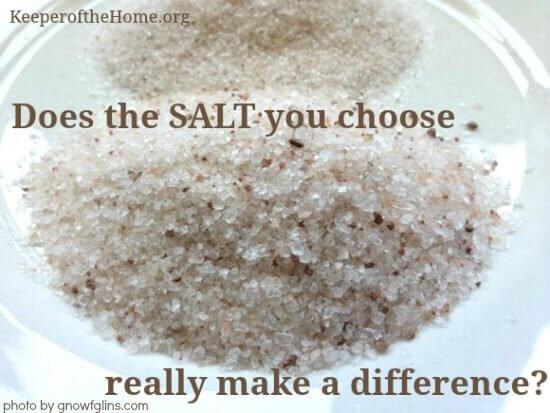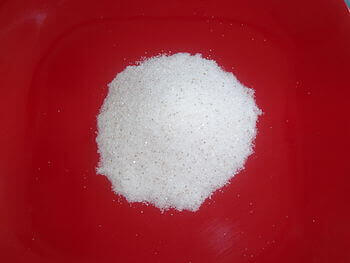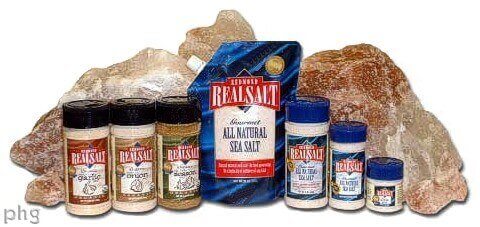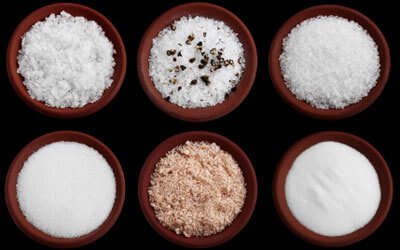Does the Salt You Choose Really Make a Difference?

Written by Stephanie Langford
Mmm, salt. I confess, I just love salty things.
It’s too bad that salt has gotten such a bad rap (along with butter– one of my other favorite culinary delights). Everywhere you look in the grocery store, pretty colored packages with sleek marketing slogans proclaim that they have “no salt”, “low salt”, or are “low in sodium”.
And we buy them up, oh yes we do. I see the coveted “low salt” labels in pantries and shopping carts galore, or hear people tell me proudly (upon discovering I write about healthy living) that they’ve cut most salt out of their diet.
Would it surprise you to hear me say that our perceptions of salt as bad and detrimental to our health are greatly maligned? (Does it honestly surprise anyone to hear me challenge yet another widely spread cultural practice? Once a rebel, always a rebel, I suppose.)
Salt is good for you. You should eat it freely. And that’s all I have to say about the matter.
(Ha! You should know me well enough by now to know that I could never have enough to say about… well, most things!)
Isn’t it bad to eat too much salt?
Maybe (or maybe not- this article brings up many compelling arguments against the “don’t eat too much salt” party line that most doctors and nutritionists are towing).
But it’s important to realize that most of the warnings about avoiding salt come because our culture is gorging itself on processed and packaged foods, that contain large amounts of additives like refined salt and sugars to make them taste good. (Because let’s face it… denatured, cardboard-like fake foods only taste good if you really sugar and salt them up).
If you’re already eating packaged foods (canned soups, crackers, chips, sauces, pre-made meals, restaurant food- especially fast food, etc.) then yes, you’re probably already getting a lot of the wrong kind of salt.
The better option is to eat a whole, real, fresh, unrefined, unprocessed diet and ditch the processed foods. Then, you won’t be consuming any refined/table salt that has already been added in to what you eat.
Instead, you’ll be able to add salt as wanted and needed. You can control it and ensure that you are only using a wholesome, life-giving salt.
Back when our family moved to eating whole foods many years ago, I learned about unrefined sea salt and that’s all that we keep in the house. Sometimes I add salt to the dishes that I am cooking and then leave it off the table. Other times, I leave it out of the food and allow each family member to salt their food to taste. Altogether, our family of 6 probably consumes a couple of tablespoons per day, give or take.

Salt is essential for life and health
Although often ignored, one notable feature of salt is that we truly NEED it.
Here’s what Wikipedia says about salt:
Chloride and sodium ions, the two major components of salt, are needed by all known living creatures in small quantities. Salt is involved in regulating the water content (fluid balance) of the body. The sodium ion itself is used for electrical signaling in the nervous system. Because of its importance to survival, salt has often been considered a valuable commodity during human history.(source)
What many people don’t know is that sodium, chloride and potassium (minerals that we get from salts) are essential for retaining the proper amount of fluid in the body, particularly around cells. Sodium also helps transmit nerve impulses and influences the contraction and relaxation of muscles (source).
Additionally, salt serves as an electrolyte. We all know how popular sports drinks are. What is it that makes them a good choice after physical exertion or on a hot day? They maintain proper hydration and cellular function in the body (especially important after you’ve been sweating), help to maintain a correct blood pH, and are critical for nerve and muscle function (ever felt weak after running or playing sports?).
Salt is even related to adrenal function, and was very helpful for me in regaining health after a period of adrenal fatigue.
The bottom line?
Salt should be regularly enjoyed in a diet of whole foods. This is a healthy and traditional way to consume salt. Our body needs at least some salt daily (more when we are working hard physically, or losing fluids because of illness).
The goal should be to avoid refined salt from processed foods, and instead include salt freely in our diet in its most natural and beneficial form… unrefined sea salt.
Why sea salt is a better choice
Unrefined sea salt, with no chemical additives, is the best salt we can eat because it follows the rules of “real food”— it is an old, traditional food (salt was always highly prized in ancient civilizations) eaten throughout history, it has not been heated to high temperatures or denatured in any other way, it contains no additives or chemicals.
It is just as it is found in nature, in a whole form with all of its components. Much as we want to keep the bran, germ and all the goodness in whole grains rather than stripping them of their nutrients, we also want to keep everything that is naturally found in salt.
Here are some of the benefits of unrefined sea salt:
- Plenty of naturally occurring minerals and trace elements, essential for our health
- No additives, anti-caking agents, aluminum derivatives, dextrose (yes, that’s a sugar), Polyethylene Glycol 400 or other nasty toxic chemicals. In this booklet, you can see some of the common ingredients added to salt.
- Amazing taste. I honestly can hardly stomach table salt anymore after years of good sea salt. Table salt tastes too strong and somewhat chemical-ish. It’s sort of bitter, too. Real sea salt has a deep and complex flavor, and more of a sweetness to it.
This post is sponsored by Redmond Trading Company, the manufacturer of the Real Salt brand. They asked me to write something (anything) that I felt like writing about. Seeing as our family has personally been buying and loving Real Salt for over 6 years, before I ever started this blog, it only made sense that I would let you know why we’ve chosen their brand as something that we want to be a part of our family’s diet. I want to be upfront with you about that, but I also want you to know that I would only promote a product to you that I would feed to my own children. That’s saying something.

What makes Real Salt so good?
Aside from the fact that once you’ve tasted real salt you’ll never want to go back, there are some other key things you should know:
It’s harvested from an ancient sea bed
Why is this important? We know that fish in the oceans and seas today contain sometimes dangerously high levels of pollutants, industrial waste and contaminants, and toxic heavy metals like mercury. There are other brands of sea salt out there that are unrefined and processed in a wonderful manner… but, they may also contain remnants of those ocean pollutants.
Real Salt comes from a mineral-rich salt deposit in Utah, USA. This deposit is what remains of an ancient sea that once covered this area of land. The salt that has been left behind is free of contamination from modern pollution, making it an even more pure choice than other sea salts. I love this graphic they’ve created to help you understand salt sources.
It is entirely unrefined- a whole food, just as God made it
Basically, the salt is mined from the food-grade veins (ie. the purest parts of the salt deposit), scraped off with special machinery, then it is screened and crushed to the proper granule size, and then screened once more before packaging to remove any impurities. No high heat, no bleaching, no chemicals or anti-caking additives, nothing.
It contains trace minerals
Since most salt is pretty much chloride and sodium, I was excited to learn about all of the trace minerals in Real Salt back when I first began to buy it. There are over 60 of them!
Take a look at this PDF document showing the mineral analysis of Real Salt. Note that many of the trace minerals are found in very, very small amounts. That might seem insignificant, but it’s not. Unlike macronutrients (protein, fat, carbohydrates), vitamins (A, C, D, etc.) and the major minerals (calcium, magnesium, potassium, sodium, iron, etc.) which we need in large quantities, there are many micronutrients that the body requires for optimal functioning, but only in very minute amounts.

Aren’t there other types of sea salts?
Yes, there sure are. In fact, “sea salt” has become quite trendy, and you’ll find various brands in even your typical grocery store, as well as a dozen gourmet versions of fancy salts in specialty stores or online. In fact, I’ve even used Himalayan Pink Salt quite happily at times, and I think that it’s a very high quality salt, as is Celtic Sea Salt.
If you’re interested in understanding the differences between them, Real Salt actually has some helpful information on comparing these three salts.
When you’re looking for salt, the most important things are to find out how the salt is mined/processed (and look for the most minimal processing possible), where it comes from (the purer the source the better), and if there are any additives (check the ingredient label- it seems ridiculous that you need to on something as basic as salt, but sadly, you do need to check it).
What about iodine?
Real Salt provides some, but not the entire recommended daily intake, as you would get with table salt that has iodine added to it. That’s fine. We shouldn’t necessarily be depending on any one food to provide us with all of a particular nutrient anyways. But, iodine is an important mineral that we want to ensure we’re getting enough of.
So where else can you get the necessary iodine? Seaweed, fish from saltwater, yogurt and milk, eggs, strawberries, potatoes with the skins on (organic is preferable) are all good sources.
My kids and I actually enjoy eating roasted seaweed paper snacks. I try to find brands that use olive, sesame or grapeseed oil (many use corn, soy or canola, which I’m not cool with), and they’re lightly salted as well. You can even get flavored versions. It’s a bit crunchy and a nice snack. We also love sushi rolls, which are made with seaweed paper. Another option is to use powdered kelp, adding small amounts in to things like soup or spaghetti sauce (just a little- like 1/4 or 1/2 tsp so the flavor isn’t too strong) or added in to your green powders that you put in smoothies. You can also buy gomasio (made with ground sesame seeds and seaweed) and sprinkle it on your rice or stir-fry (yummy!). Another great option is to boil pieces of kombu seaweed (buy this in an Asian grocery store, health food store or the ethnic aisle in your supermarket) when you’re making your homemade bone broths. When we lived in Japan, the women there taught me to use dried sardines and kombu seaweed to make their traditional “dashi” or soup stock that they use as the base for miso soup and many other dishes.
What about salt and high blood pressure?
Honestly, I don’t feel like I can really write to this question, because it’s not a health struggle we’ve had in our family and so I just haven’t looked into it as much as necessary. Much as I love to study health, I certainly don’t know about every area in detail nor am I any sort of certified professional.
There were a couple of other excellent posts I ran into as I researched this post:
Food for Thought: Is There Such a Thing as Healthy Salt? (and the follow-up Monday Mission: Switch Your Salt) both from Kitchen Stewardship
Commercial Table Salt vs. Unrefined Natural Salt from The Nourished Life
Salt and Our Health from the Weston Price Foundation website
Phew… I wrote a novel. When I first set about writing this post, I convinced myself that for once, I would try to just keep it simple and lay off all of the heavy research and details. But you know? I just can’t do it. It’s the research and the details that convinced me and inform our family’s food choices, and I think that for many of you, it’s that kind of information that makes Keeper of the Home a valuable resource to you. I try to keep it short and accessible, but ultimately? I want it to be accurate and informative, so thanks for putting up with my long-windedness.




Thanks for your helpful post. I have been looking into which salt is best and I just wanted to mention that Real Salt’s comparison of the different salts doesn’t do justice to the vast difference between their product and Celtic Sea Salt. I found a chart that has the mineral content comparision and there is no comparison. Real Salt is cheaper but to me that is the only advantage. I don’t have any connection with Celtic Sea Salt brand, just wanted to mention there is a big difference 🙂
P.S. Thanks for the wonderful ebook bundle 🙂
Great post! Everyone needs to hear this message.
My family uses Celtic sea salt, for the most part. We do still have some processed salt in the house, as my husband is not entirely sold, but as I do most of the cooking, Celtic sea salt is nearly all we use.
I use only Real Salt in my home.
The number-one characteristic that I look for in salt is color–and not from spices or herbs being added to it. Salt that is pure white has probably been tampered with, and is no longer in it’s healthy form (even with the nice label of “sea salt”). We no longer use white table salt in our home–except for weed-killing and cleaning!
Some of the salts we have enjoyed include:
Celtic Sea Salt (grey)
Himalayan Pink Salt
Hawaiian Sea Salt (red)
New Zealand Sea Salt (grey)
Hiwa Kai Black Lava Sea Salt (black lava salt with activated charcoal added)
Real salt
I figure, the more variety we have, the better. The presence of naturally-occurring color indicates minerals and stuff in the salts. I assume that means if I eat lots of different types of natural salts, I’m getting even more nutrients from them.
My favorite place to shop for these is my local Mennonite bulk food store (real salt and Himalayan salt), and T.J. Max. It’s pretty hit and miss with T.J. Max, but that’s where we’ve gotten the majority of our colored salts! It’s so fun!
I would encourage everyone to branch out and try multiple types colored salts!
You really should watch them harvest it. It has all matter of feces and debris in it. That’s why it looks that way.
Good article. We use Real Salt but when I insisted to my husband, who had cut out virtually all salt due to hypertension, that he use a little for his health, his blood pressure rose again. So this isn’t entirely “cut & dry”. My husband is African and our specialist told us that African people and I believe African-American (so we’ll need to watch for our children), have higher tendencies toward hypertension and therefore need to be more cautious. Obviously, number one is if we are going to use any salt, choose an excellent quality one like you mentioned. But secondly, if you do have a health issue, ask a lot of questions and then if you choose to try something, keep a record of how you are feeling, blood pressure readings, etc., to watch for signs of trouble.
I appreciate that you also listed other food sources, like sea vegetables, from which we can receive iodinie and minerals; I do incorporate many of these-albiet in small amounts-into our diet as well.
We use the Himalayan Pink Salt. We like it because it tastes good, and we can find it in the bulk bins locally for a great price, compared to the Celtic Salt (which we would have to order online) or the Real Salt (more expensive than buying from the bulk bins).
Also, when it comes to salt and blood pressure, a lot of people think that eating salt causes high blood pressure, which is not true, even by conventional medicine. A high salt intake will aggravate already high blood pressure, but it will not cause high blood pressure. But I do think it is more because of the highly refined, additive-filled salt and highly processed nature of the foods eaten that are the real culprit, and that real, natural salt is innocent.
Thanks for the great article explaining the difference between chemical-filled, processed salt and nutritional salt! We only use pink himalayan salt because it contains 84 essential minerals, is unprocessed, unrefined and raw. I buy it in bulk in 25 lb bags at a time, that’s how much we use it! Surprisingly, I retain fluid very easily (if I eat processed foods or foods containing processed salt), but never have that problem with the pink himalayan salt. Also, drinking a glass of warm water with some pink salt in it first thing in the morning is great way to cleanse the colon.
Great post! I just love our sea salt!
Hi,
I’m interested in knowing how this salt is replenished or is it a non-renewable resource? It won’t stop me from buying it, but was wondering if there are also other alternatives (ocean water, perhaps?) so that we don’t go through this resource like we do everything else…just trying to think ahead. 🙂
Salt, like all minerals, comes from the break-down of rocks. There are no shortages of salt or rocks so you can use it guilt-free.
I appreciate your post on salt and will certainly use some of that information in a culinary sense. As a Registered Dietitian who works on the heart floor in a hospital, I have to respectfully say that I disagree with your statement that “salt is not bad for us”. There are many well-reputed sites ( not Wikipedia) that show research backing this case. I spend my days talking with patients about how salt is bad for them and will harm their heart and body. I usually enjoy reading your posts, but had to jump in and leave a comment so that people did not get more FALSE NUTRITION information from the internet. Thank you.
Isn’t this all to do with context? The average westerner eating processed foods almost certainly has too much salt. However, when eating real food, with almost no salt present the situation is entirely different.
Since the body cannot make it’s own sodium – and it is essential for so many processes – I’m not sure how salt can be bad for you?
There are many well-reputed studies that show that unprocessed salt isn’t bad for you. Make sure that the item being studied is not processed salt, which is denatured and is unhealthy.
That you for this information. My family has switched from regular table salt to Himalayan Pink Salt and we really love it. I do have high blood pressure issues so I keep a close eye on that. The Himalayan Pink Salt doesn’t spike my blood pressure like plain white table salt does. Have you tried Himalayan Pink Salt?
I actually got myself in trouble when switching from processed food to real food, because I was used to not adding salt to anything. As I made the transition, I began making not only breakfast, lunch, and dinner, but all snacks and condiments, as well. Thankfully I noticed my health slipping and added in an unprocessed salt before it became a real problem.
I’m concerned about the iodine issue. We have fish and dairy allergies in our home, and my husband wouldn’t go near seaweed if you paid him. We looked up the amounts of iodine in the other sources noted, and found it would be tough to get enough iodine in our diet daily, short of taking a supplement. Does anyone know of any sea salts without chemical additives other than iodine?
Your point about high sodium diets being typically high in other things is spot on. Ive always wondered why research studies were so greatly desired, when most are poorly constructed and can be picked to pieces with nothing more than logic. I say yes to excellent critical thinking articles like this and no to misleading research studies. Good work!
click here
I think it’s great that you mentioned how sea salt does not have chemical additives. My wife is looking to switch our family’s diet to more healthier alternatives, and I think artisan sea salts will really help her achieve that goal. Thanks for this informative article about salts!